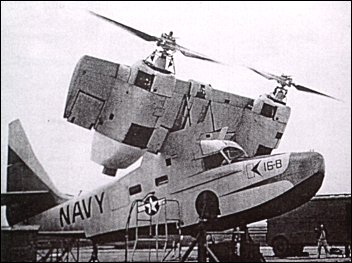In order to possess a Tilt-Wing project of its own, the Navy, after being involved with the X-18 program, decided to go its own way with a Tilt-Wing program. To that end, the service contracted the Kaman Aviation Corporation to design and build a tilt-wing VTOL vehicle, the program being given the company designation of K-16B.
Like the X-18 program, Kaman turned to existing parts and pieces for the construction of the prototype. It was decided that the fuselage of the Grumman JRF "Goose", a flying boat configuration, would exactly serve the purpose for this application, along with the fact that it was already available and wouldn't have to be fabricated from scratch.
The tilting wing, though, would have to be fabricated, which was done in-house. The wing carried a 10.4m span, but unlike other such Tilt-Wing designs which rotated to the full 90 degrees, the Kaman design would only move to a maximum 50-degree position. However, the lifting effect was enhanced since the wing contained large trailing edge flaps that enhanced the downward force effect of the wing when it was in the partially tilted attitude.
Small controllable flaps on the propeller/rotors gave the pilot control of the aircraft at speeds up to 80km/h when the conventional control surfaces were not yet effective. Above 80km/h, the flap control phased out automatically and the conventional controls took over.
The flaps were operated by a cyclic control system so that the propellers could effectively be operated as rotors. The longitudinal cyclic pitch was used to control yaw, while roll was controlled by changes in propeller pitch.
Power was adequate with a pair of General Electric T58-GE-2A turboprops, each driving giant 4.5m diameter propellers, with a projected horizontal speed of up to 480km/h.
When you really think about it, the K-16B really embodied two different VTOL concepts besides the obvious Tilt-Wing arrangement. There was also some contribution from the Deflected Slipstream technique as there was a lift enhancement from the large flaps.
As promising as this aircraft appeared, it would never take to the air. It was, however, tested In the NASA Ames wind tunnel during 1962. The reason it didn't move into a powered flight test stage is not known. Undoubtedly, the number of promising VTOL programs of the time has to play heavily in the decision.
S.Markman & B.Holder "Straight Up: A History of Vertical Flight", 2000





